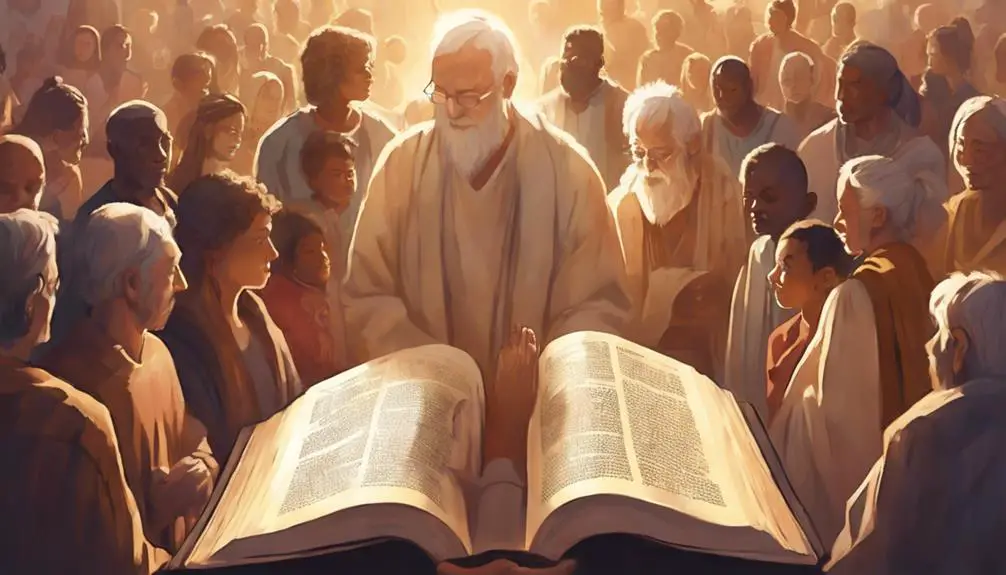The longest prayer in the Bible offers a profound journey through history and spirituality, inviting readers to explore its depths and mysteries.

Longest Prayer in the Bible
Did you know that the longest prayer in the Bible is found in Nehemiah 9:5-38? This prayer spans an impressive 33 verses, making it a significant piece of spiritual literature.
It's not just the length that's fascinating, but also the depth of historical and cultural context it offers, along with its rich themes and symbolism. As you explore this prayer further, you'll uncover insights into its impact and relevance today, which might change the way you view ancient texts.
Let's embark on this journey together, and you'll discover why this prayer has captivated scholars and believers alike for centuries.
Key Takeaways
- The longest prayer in the Bible is found in Nehemiah 9, spanning an entire chapter.
- It reflects the Israelites' deep reflection, repentance, and commitment to spiritual renewal.
- The prayer emphasizes a communal confession and the steadfast love and mercy of God.
- Its themes of repentance, renewal, and divine communication are relevant for personal and communal faith journeys today.
Identifying the Longest Prayer

In unraveling the fabric of biblical prayers, it becomes evident that the longest prayer is found in the Book of Nehemiah, chapter 9. This discovery isn't just a trivial fact; it holds significance in understanding the depth and breadth of communication with the divine as recorded in biblical texts. The prayer's length, spanning an entire chapter, indicates not only its importance but also the profound reflection and repentance of the Israelites during a pivotal moment in their history.
When you examine biblical records, the length of a prayer isn't merely about the number of words or verses; it's indicative of the weight and depth of the spiritual and communal context it addresses. Nehemiah 9 stands out because it encapsulates a collective confession and a reminder of God's steadfastness throughout Israel's history. This isn't just about duration but about the intensity and sincerity of the plea.
Understanding prayer length within the biblical corpus requires a scholarly approach, where one appreciates that these prayers weren't only spiritual utterances but also historical records. They reflect the zeitgeist of their times, the spiritual fervor, and the communal consciousness of the people. Nehemiah 9's prominence by its length underscores its significance, making it a focal point for those studying prayer in biblical records.
Historical and Cultural Context
Understanding the historical and cultural context of Nehemiah 9 requires delving into the period following the Babylonian exile, a time marked by intense reflection and communal rebuilding among the Israelites. This era was pivotal not only for its political ramifications but also for how it shaped religious practices and community life.
Here are four key aspects to consider:
- Return to Homeland: The Israelites' return from exile wasn't merely a physical journey but a spiritual reawakening, prompting a reevaluation of their covenant with God.
- Reconstruction of Identity: This period saw a deliberate effort to reconstruct a collective identity, heavily anchored in religious traditions and prayer rituals, as a cohesive force.
- Cultural Influence: Exile exposed the Israelites to diverse cultures, inevitably influencing their own practices. Yet, the prayer in Nehemiah 9 illustrates an attempt to purify and reaffirm their distinctive cultural and religious identity.
- Communal Solidarity: The collective participation in prayer rituals served not only as a spiritual exercise but also reinforced communal bonds, crucial for their survival and rebuilding efforts.
This context underscores the depth and complexity behind the longest prayer in the Bible, reflecting an intersection of faith, culture, and community resilience.
Analyzing the Prayer's Content

Delving into the prayer's content, you'll find it serves as a profound reflection on the Israelites' collective history, emphasizing their enduring relationship with God amidst trials and tribulations. This prayer doesn't just recount historical events; it weaves them into a narrative that highlights the emotional depth and spiritual resilience of the people. The prayer structure itself is a testament to their introspective journey, with each segment leading the community through a process of reflection, repentance, and renewal.
Aspect |
Analysis |
|---|---|
Prayer Structure |
Chronological recounting with reflective pauses. |
Emotional Depth |
Expresses a range of emotions from anguish to hope. |
Relationship with God |
Depicts a dynamic, covenant-based relationship. |
Reflection |
Encourages introspection and acknowledgment of past mistakes. |
Renewal |
Concludes with a commitment to spiritual revival. |
The prayer's content is rich in its examination of the human condition, particularly in the context of a covenant relationship with the divine. It's a dialogue that not only recounts the past but also sets a tone for future aspirations. The emotional depth embedded within its structure encourages a personal and communal reflection, making it a powerful piece for study and meditation.
Themes and Symbolism
Exploring themes and symbolism, you'll uncover layers of meaning that deepen the prayer's impact on readers and listeners alike. Through this prayer, themes of divine communication and spiritual intimacy are woven intricately, offering a profound understanding of the relationship between the divine and humanity. Here are four key elements that emerge:
- Divine Communication: Symbolized through the act of prayer itself, this theme underscores the importance of a continuous dialogue with the divine. It suggests that communication isn't unilateral but a reciprocal exchange, fostering a deeper spiritual connection.
- Spiritual Intimacy: The depth of the words used in the prayer symbolizes an intimate relationship with the divine, one that transcends mere ritualistic practices. It reflects a yearning for closeness and a genuine understanding of divine will.
- Intercession: Symbolizing the act of pleading on behalf of others, intercession highlights the communal aspect of faith, emphasizing the interconnectedness of all believers in their spiritual journey.
- Repentance and Renewal: Through symbolic acts of confession and pleas for forgiveness, the prayer embodies themes of repentance and the desire for spiritual renewal. This represents the perpetual cycle of human imperfection, divine forgiveness, and the pursuit of a more righteous path.
These themes and symbols enrich the prayer, offering a tapestry of insights into divine communication and spiritual intimacy that resonate with believers on a profound level.
Impact and Relevance Today

In today's rapidly evolving spiritual landscape, the longest prayer in the Bible maintains its relevance, offering timeless wisdom that continues to guide and inspire believers in their personal and communal faith journeys. This prayer's enduring impact lies in its capacity to transcend cultural and historical boundaries, making its teachings as pertinent now as they were centuries ago. Its themes of confession, redemption, and hope resonate deeply with contemporary audiences, encouraging personal reflections and a communal sense of belonging and purpose.
The application of this prayer in modern contexts demonstrates its versatility and the profound effect it can have on individual lives and society as a whole. It serves as a tool for introspection, allowing you to explore your faith and the complexities of the human condition in a nuanced way. Moreover, it fosters a sense of unity and shared values among communities, proving that its words aren't just ancient texts but living documents that continue to inspire and challenge.
As you reflect on this prayer, consider how its words resonate with your personal experiences and the world around you. Its ability to speak to modern applications of faith and spirituality underscores its timeless relevance, providing a foundation upon which to build a life of meaning and connection.
Frequently Asked Questions
How Has the Translation of the Longest Prayer in the Bible Affected Its Interpretation and Understanding Among Different Christian Denominations?
The translation methodology of this significant prayer has greatly influenced its interpretation and understanding across various Christian denominations.
You'll find that denominational differences often stem from nuanced linguistic choices made during translation.
These choices can echo or amplify theological perspectives, leading to diverse receptions and teachings within communities.
Reflecting on this, it's clear that the way we translate and interpret sacred texts profoundly shapes our collective and individual faith experiences.
Are There Any Specific Rituals or Traditions in Various Religions or Denominations That Involve the Recitation of the Longest Prayer in the Bible?
You're diving into an ocean of faith, where the depth varies across traditions. In exploring ritual variations, it's clear that prayer length is more than words; it's a bridge to the divine.
Some denominations embrace the recitation of lengthy prayers within specific rituals, seeing it as a profound act of devotion. This practice reflects a rich tapestry of belief, where the length serves not just to petition, but to connect deeply with the spiritual.
How Do Contemporary Theologians and Scholars Differ in Their Views on the Practical Applications of the Teachings Found in the Longest Prayer?
You'll find that contemporary theologians and scholars diverge significantly in their interpretations of the practical applications of this prayer's teachings. Their analyses often reflect the prayer duration's spiritual significance and its cultural influences on modern faith practices.
While some view it as a guide for deep, personal reflection, others argue its utility in communal worship settings, thereby demonstrating the broad spectrum of scholarly thought on its relevance today.
Can the Structure and Literary Devices Used in the Longest Prayer Provide Insights Into the Educational or Rhetorical Methods of Ancient Religious Leaders?
You're diving deep, aren't you? Exploring how the structure and literary devices unlock the secrets of ancient eloquence and educational prowess.
By analyzing prayer metrics, you're essentially cracking the code to ancient rhetorical genius. It's like finding the blueprint to history's most persuasive speeches.
This quest doesn't just tickle your fancy for scholarly reflection; it unveils the meticulous craftsmanship behind those timeless teachings. Truly, a masterclass in ancient wisdom.
What Are the Challenges Faced by Modern Believers in Relating the Messages of the Longest Prayer to Current Global Issues and Personal Life Challenges?
You face challenges in relating ancient texts to today's global issues and personal struggles due to historical context and technological distractions. These texts, while rich in wisdom, come from a world vastly different from ours, making it hard to see their relevance.
Technological distractions further complicate this, pulling your focus away from deep reflection. Analyzing these ancient writings requires a reflective, scholarly approach to uncover their enduring messages amidst modern chaos.
Conclusion
As you've journeyed through the tapestry of the longest prayer in the Bible, you've traversed historical landscapes and delved into rich thematic layers. This prayer, much like a lighthouse, illuminates the profound connection between humanity and the divine, guiding souls through the tumultuous seas of life.
Its relevance today remains undiminished, offering a beacon of hope and understanding in our quest for spiritual grounding. Reflecting on its words encourages a deeper exploration of our own beliefs and the world around us.



Sign up